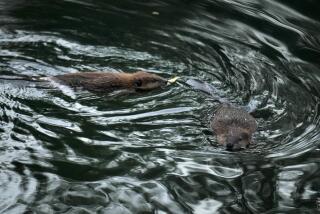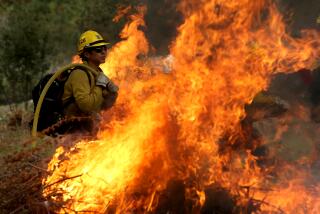New forest rises from ashes
CUYAMACA, Calif. -- Atop Cuyamaca Peak, imperious Santa Ana winds shook the blackened skeletons of burned trees and chaparral as Shane Coles poked about, looking for reasons to take heart.
A coffee berry shrub whose dead stalks rose to a height of 6 feet had sprouted new green shoots already a third of the size of those burned. A big, squat Coulter pine, dead of fire, dangled half a dozen empty, football-sized cones over the rocky edge of the mountain. “Hopefully, they dropped their seeds and some of them will take,” Coles said.
A year ago, the historic Cedar wildfire all but obliterated the majestic mountain forests of Cuyamaca Rancho State Park, resetting human expectations for many generations to come. Of the site’s 25,000 acres, only 300 escaped burning, in the worst fire ever to strike a state park.
Like a family that has weathered a year of birthdays and holidays since the death of a loved one, the people attached to Cuyamaca Rancho have completed a cycle of grieving.
“We all knew a big fire was going to happen,” said Coles, who retired this year after 16 years as a ranger at the park. “We just hoped we’d be lucky, and it wouldn’t happen in our lifetimes. It’s part of the adjustment process to start accepting the landscape as it is.”
Recently park officials conducted a two-day scientific symposium to mark the first anniversary of the conflagration, one of several simultaneous wildfires that burned nearly 740,000 acres and killed 26 people in Southern California last fall.
The symposium was titled “The Cedar Fire and Cuyamaca Rancho State Park One Year Later: Recovery Expectations and Realities.” It was an early attempt to identify some of the plants and animals that are winners and losers on the altered landscape and address how the park’s natural regeneration is likely to unfold.
It also signaled that the time for emotionalism was past.
The park is sometimes referred to as “San Diego’s playground” (it is about 40 miles east of the city). Ordinarily its tree canopy would be taking on the yellow-green of autumn at this time of year. But with a million mature trees estimated to have died and countless others damaged, there is little such color change this year.
Since the park reopened in May, visitation has been down 75% from its pre-fire annual rate of 600,000 people. “But our day use is really picking up,” said Laura Itogawa, Cuyamaca Rancho’s insistently positive superintendent, “because people are realizing we’re open and we’re beautiful.”
A Renaissance
Rebirth and new life are apparent in the exuberant green sprouting from the stumps and branches of burned oaks and in the fire-following plant species that, with the forest canopy gone, are literally having their day in the sun.
Since spring, Cuyamaca Rancho has been continuously in bloom. Currently, California fuchsia and scarlet monkey flower smear portions of hillsides and gullies in red.
“We’re going to have great wildflowers for the next five years,” Coles said as her SUV bumped along a fire road choked with sticky manna, a marijuana-like fire-follower whose purple tubular flowers will set a feast for hummingbirds when they bloom next spring. “This summer I saw wildflowers I never saw before.”
In the park’s lower-lying West Mesa area, Coles found numerous robust baby pines, some already 14 inches tall. As if aware of their fragile future, the tiny trees huddled like frightened infants near the giant corpses of their parents, which, even in death, provide some protection from hot sun and drying winds.
Nearby, the verdant stump sprouts of burned black oaks stretched to a height of 7 feet. The limbs of scorched live oaks seemed to be holding piles of furry green melons -- ball-shaped collections of sprouts.
On West Mesa, 70 deer and other species of wildlife perished in the fire. The tableau of their corpses in anguished poses on the barren hillside became an emotional symbol of what befell Cuyamaca Rancho.
Now the mesa is an even more favorable habitat for deer than it was before the fire.
Walter Boyce, a UC Davis researcher who has conducted numerous wildlife studies at Cuyamaca, said that 10% to 20% of the park’s deer died in the fire, leaving as many as 800 still afoot. The survivors have since produced a new generation of fauns that have grown fat on the abundance of tender young shoots.
Deer are the favored prey of mountain lions and, Boyce said, since June, researchers have identified three of the predators in the park.
Kangaroo rats, pocket mice and California mice also prosper after fires. Living underground, they survive flames “and then they come up and their competition is gone,” said Wayne Spencer of the San Diego Natural History Museum. Moreover, the seeds they feed on are newly accessible beneath the fire-stripped soil.
In time, he said, the proliferation of rodents will stimulate the recovery of such carnivores as coyotes, bobcats and foxes, all of which have returned.
The park’s population of Arroyo toads has increased since the fire, researchers said. By wiping out vegetation along streams, the blaze opened new stretches of habitat to the endangered amphibians. With no vegetation to draw off moisture, more surface water has become available to them.
Not all wildlife was so blessed by the fire.
Forest birds face a bleak future, said park ecologist Paul Jorgensen.
“I’ve seen some acorn woodpeckers, but I don’t know what they’re going to eat for the next five years,” he said. “Woodpeckers and sapsuckers are going to be in trouble in this area, and owls we really think are going to get hard hit.”
Rabbits, wood rats, chipmunks and tree squirrels died in large numbers. Because they depend on trees and chaparral for cover, “it will take a long time, if ever, to support such species,” Spencer said.
Long Odds for Pines
Pine trees, some as old as 500 years, peacefully coexisted with oaks in Cuyamaca Rancho’s woodlands before the fire. Now they face a long-odds struggle for existence among the better fire-adapted oaks.
Unlike oaks, burned conifers cannot sprout but must reproduce from seeds, a more harrowing process. Moreover, the fire was so intense it burned pine seeds in their cones and destroyed caches of seeds hidden in the soil by squirrels and birds.
Janet Franklin, a biology professor at San Diego State University, recently surveyed an area of the park’s West Mesa and found that 95% of its 1,163 conifers had been lost to the fire. On all of West Mesa, Franklin and her colleagues counted 371 pine seedlings, “and we would really have liked to have seen tens of thousands.”
At the symposium, Richard Minnich, a geology professor at UC Riverside and an expert on fire ecology, raised a possibility that is anathema to park officials -- planting pine seedlings rather than allowing the forest to regenerate naturally.
Cuyamaca Rancho, Minnich said, was “at the threshold of a basic vegetative conversion. It’s not going to take care of itself on its own. It’s going to become an oak forest. If you want a pine forest, you may have to take artificial measures.”
Too much rain and too little moisture are twin perils that haunt the park.
Immediately after the blaze, officials feared heavy winter rains would cause massive erosion.
Instead, a years-long drought continued, and it augurs ill for fire-weakened trees and long-term new growth.
By last spring, enough rain had fallen to turn the lowland meadows of the park bright green with new wildflowers and grasses, while Cuyamaca’s three forested peaks brooded in black and brown. Over summer and fall, the meadows dried to a brittle gold, while on the ashy soil of the three peaks -- newly exposed to sun -- bracken fern and other ground cover laid a sparse carpet of green at the feet of destroyed trees.
At the symposium, the annual cycle of greening fooled no one. Everyone was talking drought.
Rain, however, can be capricious.
A few hours after the first day’s proceedings, a storm descended on Cuyamaca Rancho, and the events of the symposium’s second day, devoted to guided field tours, had to be canceled.
The rains fell harder as the week progressed, totaling nearly 9 inches. The park’s streams swelled and debris washed down the steep slopes.
Many dead trees, unable to keep their footing in the suddenly mushy soil, toppled. Numerous live trees, unaccustomedly heavy with absorbed water, fell too.
More to Read
Start your day right
Sign up for Essential California for news, features and recommendations from the L.A. Times and beyond in your inbox six days a week.
You may occasionally receive promotional content from the Los Angeles Times.






